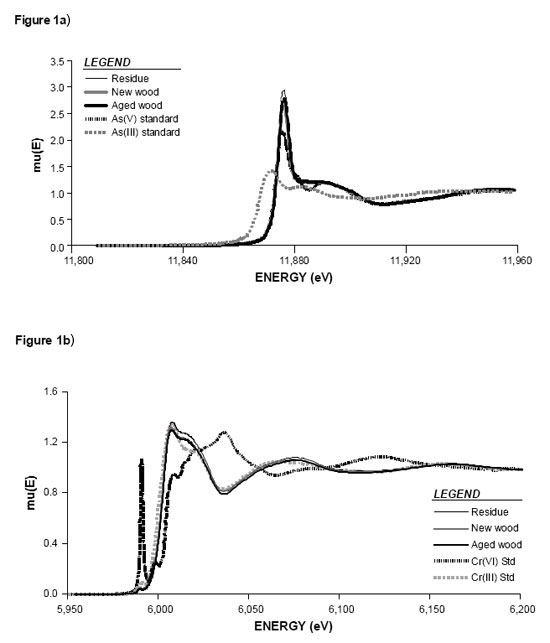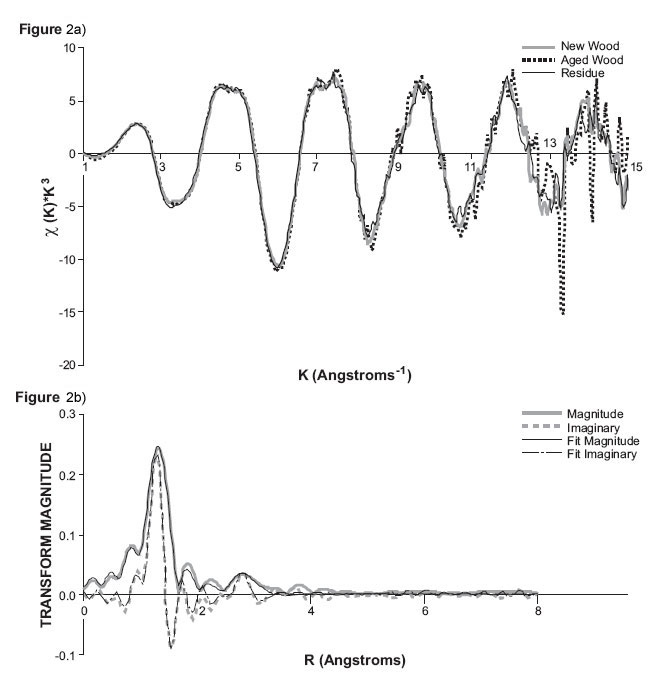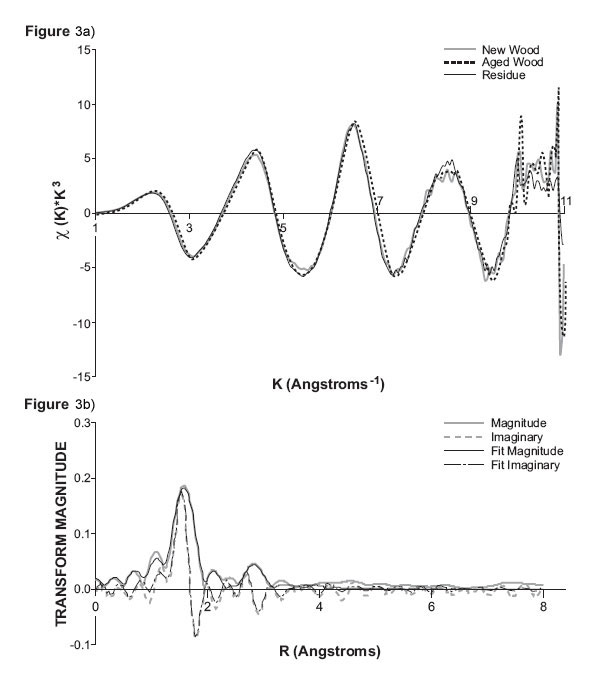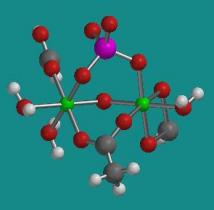
In recent years, regulatory and public attention has become focused on the potential risks associated with exposure to chromated copper arsenate (CCA)-treated wood - the most widely used wood treatment product in the United States. CCA has been used to treat lumber for over 60 years (1), mainly because of the extended lifetime of CCA-treated wood as compared to untreated wood (2-5) and the higher costs of non-wood alternatives. Since the late 1980s,U.S. production of CCA-treated wood has averaged approximately 5 x 108 ft3/y (6) and by 1996, sales of treated wood products reached over $3.9 billion (1). Although in January 2004 a voluntary ban on CCA for residential use went into effect, it is estimated that 300,000 metric tons of As have been used in CCA production since 1975 with most of that product still remaining in use today (7). Because of the potential toxicity of the metal constituents of CCA, attention has become focused on the potential risks from this exposure source, and in particular, the exposure of children to arsenic from CCA-treated wood used in decks and play sets. As a result, the U.S. EPA Office of Pesticide Programs (OPP) is currently preparing a human health risk assessment for direct-contact exposures to CCA-treated wood. Using the assumptions proposed in its initial 2001 exposure evaluation methodology, the U.S. EPA suggested that the major routes of arsenic exposure to younger children, 1 to 6 years, from CCA products would be through contact with wood residues, with roughly 50% coming through dermal absorption of arsenic and 46% coming through incidental ingestion. The dermal absorption estimate was calculated by assuming that 6.4% of a dermally applied arsenic dose would be absorbed. The remaining 4% of the exposure was estimated to come from exposure to arsenic containing soils.

Understanding the chemical and structural state of chromium (Cr) and arsenic (As) within CCA-treated wood is an essential component of better understanding human exposure and potential risk from As and Cr and therefore refining EPA's initial estimates. However, although the chemical and structural environment of As and Cr in CCA-treated wood had been speculated (2,3,8-10), it remained unresolved. To investigate the questions around the chemical and structural state of Cr and As in CCA-treated wood, extended X-ray absorption spectroscopy (EXAFS) and X-ray absorption near-edge spectroscopy (XANES) were conducted at beamline 4-3 at the Stanford Synchrotron Radiation Laboratory. Synchrotron X-ray techniques were the ideal method for this investigation because they yield crucial information on the oxidation state of the As and Cr as well as their molecular structures, without inducing any sample-handling artifacts. The oxidation state information, obtained through XANES, is critical because both As and Cr can exist in two different oxidation states, As(III), As(V) and Cr(III), Cr(VI). The oxidation state has important implications for potential exposure because As(V) and Cr(III) are both less toxic and less mobile than their oxidation state counterparts, As(III) and Cr(VI). In addition, the molecular structures, obtained through EXAFS analyses, is essential in predicting the stability of the As and Cr in these CCA materials and with respect to environmental release and human contact.
Three different types of CCA-treated materials were evaluated: newly treated wood, aged wood, and dislodgeable residue from aged CCA-treated wood. The dislodgeable residue was chosen to represent that fraction of CCA treated materials most accessible to humans. The new vs. aged wood comparison was used to determine any effects of environmental weathering on As and Cr chemistry of treated wood. For the two solid wood samples (fresh and aged), a 2- 3- 1-cm subsection of the wood was removed for analysis (the top side of the weathered CCA-treated wood was used). The residue used in this study, in the form of a fine particulate, was supplied by the American Chemistry Council's CCA-Treated Wood Group. The sample was derived from CCA-treated boards that were removed from in-service residential decks in Michigan and Georgia, and consisted of either Southern Yellow Pine or Ponderosa Pine. Deck structures had been weathered in the environment for 1 to 4 years and had no coatings. This dislodgeable material was collected by gently brushing the board with a soft-bristle test-tube brush while rinsing with deionized water.

The As and Cr XANES are shown in Figure 1a and 1b. The similarity between the XANES of Standards and the XANES of the CCA treated materials indicated the As was present as As(V) and the Cr as Cr(III) - the less toxic and less mobile states of these atoms- in all of the materials tested. In addition, the As and Cr EXAFS were comparable in all three samples, indicating that weathering had not significantly altered the chemical environment, Figures 2a and 3a. Although all three materials appeared to have the same local chemical structure, the dislodgeable residue was chosen for detailed EXAFS analysis because it best represents the type of CCA material most accessible to humans. Conventional fitting of the As and Cr EXAFS of the dislodgeable residue, Figures 2b and 3b yielded several important facts that help to answer questions about the chemical and structural state of Cr and As in CCA-treated wood. In the As spectrum, a Cr neighbor at a distance of 3.25 Å is seen. As would be expected, the Cr EXAFS shows an As neighbor at the same distance, 3.25 Å. In addition, the Cr spectrum indicates that Cr has an additional neighboring Cr at a distance of 3.47 Å. Lastly the Cr spectrum also appears to include the influence of several C neighbors at an average distance of 3.08 Å. The contribution of the C neighbors to the overall Cr spectra is relatively small, but it is included in the final model of the Cr chemical environment, which incorporates constraining complementary information from previously published studies. The validity of these atomic neighbors and distances are shown in Figures 2b and 3b. These figures show the calculated EXAFS spectra, assuming the features described above, and compare them with the spectra empirically acquired at SSRL.
Like a jigsaw puzzle, when the various atomic neighbors and distances are fitted together they result in a structure shown in Figure 4. The Cr atoms (green) are found as dimer linked by an oxygen (red) and a carboxylic group (R-CO2-, carbon in gray). In addition the two Cr atoms are bridged by an AsO43- tetrahedron (As in purple). This structure has several important features. First, it accounts for the Cr-to-As molar ratio present in the residue and the aged wood sample, 1.7:1 and 2.2:1, respectively. Similarly, it is in excellent agreement with the 2:1 Cr-to-As molar ratio present in the initial CCA treating solution (2). Second, it indicates that the AsO43- is bound with two different Cr atoms in a conformation commonly described as a binuclear bidentate complex. A complex such as this is expected to be relatively stable because of the lack on any significant steric strain and because of the necessity of hydrolyzing two Cr-O-As bonds in order to release the AsO43- ion. Third, the presence of the C atoms indicates that the entire structure is linked in some manner to the organic structure of the wood. This is in some ways to be expected because the Cr in the initial CCA treated solution is present as Cr(VI) and in order to be reduced to Cr(III) must react with the organics in the wood. However, the fact that the structure retains its connection to the wood further signals that it is relatively resistant to leaching.

A study published in 2004 measured the in vivo dermal absorption of As from CCA residue, and reported that As absorption was below study detection limits, in spite of dietary As being minimized through the use of a special low As diet (11). They estimated a dermal absorption value of less than 0.16% or indistinguishable from background As levels. This very low availability of As from residue is supported by the relatively high expected-stability of the complex shown in Figure 3, and the two studies serve to validate one another. The combination of these two studies would seem to indicate that the initially-estimated dermal absorption value for As of 6.4% is significantly too high. In fact, it appears that dermal absorption of As from CCA treated materials is likely to be a much less significant pathway than currently estimated under default assumptions proposed by the U.S. EPA and could, perhaps, be eliminated from consideration as a significant exposure pathway for arsenic from CCA-treated wood.
- Hingston, J. A.; Collins, C. D.; Murphy, R. J.; Lester, J. N. Env. Poll. 2001, 111, 53-66.
- Bull, D. C.; Harland, P. W.; Vallance, C.; Foran, G. J. J. Wood Science 2000, 46, 248-252.
- Bull, D. C. Wood Sci. and Technol. 2001, 34, 459-466.
- Zagury, G. J.; Samson, R.; Deschenes, L. J. Environ. Qual. 2003, 32, 507-514.
- Balasoiu, C. f.; Zagury, G. J.; Deschenes, L. Sci. Total Env. 2001, 280, 239-255.
- Solo-Gabrielle, H.; Townsend, T. "Generation, use, disposal and management options for CCA-treatedd wood," Florida Center for Solid and Hazardous Waste Management, 1998.
- Belluck, D. A.; Benjamin, S. L.; Sampson, J.; Johnson, B. Int. J. Toxicology 2003, 22, 109-128.
- Woolson, E. A.; Gjovik, L. R. 1981, 77, 15-22.
- Kamdem, D. P. "ESEM of CCA Type C Treated Southern Pine," Osmose Inc., 2001.
- Kamdem, D. P.; Cui, W. "X-ray Diffraction of CCA Treated Wood Surface," Osmose Inc., 2001.
- Wester, R. C.; Hui, X.; Barbadillo, S.; Maibach, H. I.; Lowney, Y. W.; Schoof, R. A.; Holm, S. E.; Ruby, M. V. Tox. Sci. 2004, 79, 287-295.
Nico, P. S.; Fendorf, S. E.; Lowney, Y. W.; Holm, S. E.; Ruby, M. V. "Chemical Structure of Arsenic and Chromium in CCA-treated Wood: Implications of Environmental Weathering," Environ. Sci. Technol. 2004, 38, 5253-5260.




